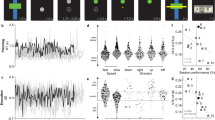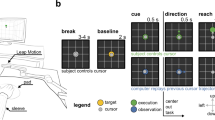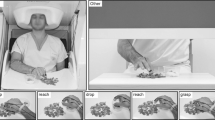Abstract
Continuous and sequential movements are controlled by widely distributed brain regions. A series of studies have contributed to understanding the functional role of these regions in a variety of visuomotor tasks. However, little is known about the neural interactions underpinning continuous movements. In the current study, we examine the spatiotemporal neural interactions underlying continuous drawing movements and the association of them with behavioral components. We conducted an experiment in which subjects copied a pentagon continuously for ~45 s using an XY joystick, while neuromagnetic fluxes were recorded from their head using a 248-sensor whole-head magnetoencephalography (MEG) device. Each sensor time series was rendered stationary and non-autocorrelated by applying an autoregressive integrated moving average model and taking the residuals. We used the directional variability of the movement as a behavioral measure of the controls generated. The main objective of this study was to assess the relation between neural interactions and the variability of movement direction. That is, we divided the continuous recordings into consecutive periods (i.e., time-bins) of 51 steps duration and computed the pairwise cross-correlations between the prewhitened time series in each time-bin. The circular standard deviation of the movement direction within each time-bin provides an estimate of the directional variability of the 51-ms trajectory segment. We looked at the association between neural interactions and variability of movement direction, separately for each pair of sensors, by running a cross-correlation analysis between the strength of the MEG pairwise cross-correlations and the circular standard deviations. We identified two types of neuronal networks: in one, the neural interactions are correlated with the directional variability of the movement at negative time-lags (feedforward), and in the other, the neural interactions are correlated with the directional variability of the movement at positive time-lags (feedback). Sensors associated mostly with feedforward processes are distributed in the left hemisphere and the right occipital–temporal junction, whereas sensors related to feedback processes are distributed in the right hemisphere and the left cerebellar hemisphere. These results are in line with findings from a series of previous studies showing that specific brain regions are involved in feedforward and feedback control processes to plan, perform, and correct movements. Additionally, we looked at whether changes in movement direction modulate the neural interactions. Interestingly, we found a preponderance of sensors associated with changes in movement direction over the right hemisphere—ipsilateral to the moving hand. These sensors exhibit stronger coupling with the rest of the sensors for trajectory segments with high rather than low directional movement variability. We interpret these results as evidence that ipsilateral cortical regions are recruited for continuous movements when the curvature of the trajectory increases. To the best of our knowledge, this is the first study that shows how neural interactions are associated with a behavioral control parameter in continuous and sequential movements.









Similar content being viewed by others
References
Andres FG, Mima T, Schulman AE, Dichgans J, Hallett M, Gerloff C (1999) Functional coupling of human cortical sensorimotor areas during bimanual skill acquisition. Brain 122:855–870
Ashe J, Georgopoulos AP (1994) Movement parameters and neural activity in motor cortex and area 5. Cereb Cortex 4:590–600
Averbeck BB, Chafee MV, Crowe DA, Georgopoulos AP (2003) Neural activity in prefrontal cortex during copying geometrical shapes. I. Single cells encode shape, sequence, and metric parameters. Exp Brain Res 150:127–141
Averbeck BB, Crowe DA, Chafee MV, Georgopoulos AP (2009) Differential contribution of superior parietal and dorsal-lateral prefrontal cortices in copying. Cortex 45:432–441
Bastian AJ (2006) Learning to predict the future: the cerebellum adapts feedforward movement control. Curr Opin Neurobiol 16:645–649
Box GEP, Jenkins GM, Reinsel GC (2008) Time series analysis: forecasting and control. Holden Day, San Francisco
Buneo CA, Andersen RA (2006) The posterior parietal cortex: sensorimotor interface for the planning and online control of visually guided movements. Neuropsychologia 44(13):2594–2606
Caminiti R, Chafee MV, Battaglia-Mayer A, Averbeck BB, Crowe DA, Georgopoulos AP (2010) Understanding the parietal lobe syndrome from a neurophysiological and evolutionary perspective. Eur J Neurosci 31:2320–2340
De Renzi E (1982) Disorders of space exploration and cognition. Elsevier, Amsterdam
Desmurget M, Grafton S (2000) Forward modeling allows feedback control for fast reaching movements. Trends Cogn Sci 4:423–431
Desmurget M, Epstein CM, Turner RS, Prablanc C, Alexander GE, Grafton S (1999) Role of the posterior parietal cortex in updating reaching movements to a visual target. Nat Neurosci 2:563–567
Gerloff C, Richard J, Hadley J, Schulman AE, Honda M, Hallett M (1998) Functional coupling and regional activation of human cortical motor areas during simple, internally paced and externally paced finger movements. Brain 121:1513–1531
Gevins AS, Schaffer RE, Doyle JC, Cutillo BA, Tannehill RS, Bressler S (1983) Shadows of thought: shifting lateralization of human brain electrical patterns during brief visuomotor task. Science 220:97–99
Granger CWJ, Newbold P (1974) Spurious regressions in econometrics. J Econom 2:111–120
Granger CWJ, Newbold P (1977) Forecasting economic time series. Academic, New York, NY
Grea H, Pisella L, Rossetti Y, Desmurget M, Tilikete C, Grafton S, Prablanc C, Vighetto A (2002) A lesion of the posterior parietal cortex disrupts on-line adjustments during aiming movements. Neuropsychologia 40:2471–2480
Grol MJ, Majdandzić J, Stephan KE, Verhagen L, Dijkerman HC, Bekkering H, Verstraten FA, Toni I (2007) Parieto-frontal connectivity during visually guided grasping. J Neurosci 27:11877–11887
Houk JC, Buckingham JT, Barto AG (1996) Models of the cerebellum and motor learning. Behav Brain Sci 19:368–383
Jenkins GM, Watts DG (1968) Spectral analysis and its applications. Holden Day, San Francisco
Kawato M, Gomi H (1992) A computational model of four regions of the cerebellum based on feedback-error learning. Biol Cybern 68:95–103
Krams M, Rushworth MF, Deiber MP, Frackowiak RS, Passingham RE (1998) The preparation, execution and suppression of copied movements in the human brain. Exp Brain Res 120:386–398
Langheim FJ, Merkle AN, Leuthold AC, Lewis SM, Georgopoulos AP (2005) Dipole analysis of magnetoencephalographic data during continuous shape copying. Exp Brain Res 170:513–521
Leuthold AC (2003) Subtraction of heart artifact from MEG data: the matched filter revisited. Soc Neurosci Abstr 863.15
Leuthold AC, Langheim FJ, Lewis SM, Georgopoulos AP (2005) Time series analysis of magnetoencephalographic data during copying. Exp Brain Res 164:411–422
Luria AR, Tsvetkova LS (1964) The programming of constructive activity in local brain injuries. Neuropsychologia 2:95–107
Miall RC, Imamizu H, Miyauchi S (2000) Activation of the cerebellum in co-ordinated eye and hand tracking movements: an fMRI study. Exp Brain Res 135:22–33
Moran D, Schwartz AB (1999a) Motor cortical representation of speed and direction during reaching. J Neurophysiol 82:2676–2692
Moran DW, Schwartz AB (1999b) Motor cortical activity during drawing movements: population representation during spiral tracing. J Neurophysiol 82:2693–2704
Nowak DA, Timmann D, Hermsdörfer J (2007) Dexterity in cerebellar agenesis. Neuropsychologia 45:696–703
Priestley MB (1981) Spectral analysis and time series. Academic, San Diego, CA
Rao SM, Binder JR, Bandettini PA, Hammeke TA, Yetkin FZ, Jesmanowicz A, Lisk LM, Morris GL, Mueller WM, Estokowski LD et al (1993) Functional magnetic resonance imaging of complex human movements. Neurology 43:2311–2318
Salmelin R, Forss N, Knuutila J, Hari R (1995) Bilateral activation of the human somatomotor cortex by distal hand movements. Electroencephalogr Clin Neurophysiol 95:444–452
Schwartz AB (1994) Direct cortical representation of drawing. Science 265:540–542
Seidler RD, Noll DC, Thiers G (2004) Feedforward and feedback processes in motor control. Neuroimage 22:1775–1783
Shadmehr R, Krakauer JW (2008) A computational neuroanatomy for motor control. Exp Brain Res 185:359–381
Toma K, Mima T, Matsuoka T et al (2002) Movement rate effect on activation and functional coupling of motor cortical areas. J Neurophysiol 88:3377–3385
Tzagarakis C, Jerde TA, Lewis SM, Uğurbil K, Georgopoulos AP (2009) Cerebral cortical mechanisms of copying geometrical shapes: a multidimensional scaling analysis of fMRI patterns of activation. Exp Brain Res 194:369–380
Van Mier HI, Petersen SE (2002) Role of the cerebellum in motor cognition. Ann N Y Acad Sci 978:334–353
Wu W, Gao Y, Bienenstock E, Donoghue JP, Black MJ (2006) Bayesian population decoding of motor cortical activity using a kalman filter. Neural Comput 18:80–118
Acknowledgments
This study was supported by the American Legion Brain Sciences Chair and the US Department of Veterans Affairs. We thank Dr. J. Bonaiuto for comments on the manuscript and for discussions.
Author information
Authors and Affiliations
Corresponding author
Rights and permissions
About this article
Cite this article
Christopoulos, V.N., Leuthold, A.C. & Georgopoulos, A.P. Spatiotemporal neural interactions underlying continuous drawing movements as revealed by magnetoencephalography. Exp Brain Res 222, 159–171 (2012). https://doi.org/10.1007/s00221-012-3208-3
Received:
Accepted:
Published:
Issue Date:
DOI: https://doi.org/10.1007/s00221-012-3208-3




